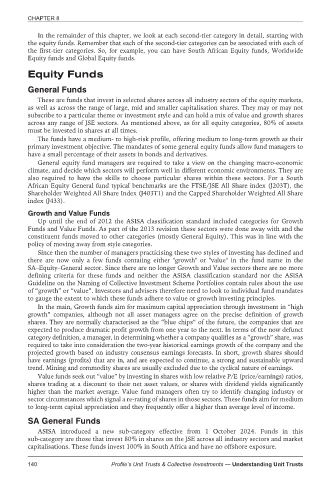Page 142 - Profile's Unit Trusts & Collective Investments - March 2025
P. 142
CHAPTER 8
In the remainder of this chapter, we look at each second-tier category in detail, starting with
the equity funds. Remember that each of the second-tier categories can be associated with each of
the first-tier categories. So, for example, you can have South African Equity funds, Worldwide
Equity funds and Global Equity funds.
Equity Funds
General Funds
These are funds that invest in selected shares across all industry sectors of the equity markets,
as well as across the range of large, mid and smaller capitalisation shares. They may or may not
subscribe to a particular theme or investment style and can hold a mix of value and growth shares
across any range of JSE sectors. As mentioned above, as for all equity categories, 80% of assets
must be invested in shares at all times.
The funds have a medium- to high-risk profile, offering medium to long-term growth as their
primary investment objective. The mandates of some general equity funds allow fund managers to
have a small percentage of their assets in bonds and derivatives.
General equity fund managers are required to take a view on the changing macro-economic
climate, and decide which sectors will perform well in different economic environments. They are
also required to have the skills to choose particular shares within these sectors. For a South
African Equity General fund typical benchmarks are the FTSE/JSE All Share index (J203T), the
Shareholder Weighted All Share Index (J403T1) and the Capped Shareholder Weighted All Share
index (J433).
Growth and Value Funds
Up until the end of 2012 the ASISA classification standard included categories for Growth
Funds and Value Funds. As part of the 2013 revision these sectors were done away with and the
constituent funds moved to other categories (mostly General Equity). This was in line with the
policy of moving away from style categories.
Since then the number of managers practicising these two styles of investing has declined and
there are now only a few funds contaiing either "growth" or "value" in the fund name in the
SA–Equity–General sector. Since there are no longer Growth and Value sectors there are no more
defining criteria for these funds and neither the ASISA classification standard nor the ASISA
Guideline on the Naming of Collective Investment Scheme Portfolios contain rules about the use
of “growth” or “value”. Investors and advisers therefore need to look to individual fund mandates
to gauge the extent to which these funds adhere to value or growth investing principles.
In the main, Growth funds aim for maximum capital appreciation through investment in “high
growth” companies, although not all asset managers agree on the precise definition of growth
shares. They are normally characterised as the “blue chips” of the future, the companies that are
expected to produce dramatic profit growth from one year to the next. In terms of the now defunct
category definition, a manager, in determining whether a company qualifies as a “growth” share, was
required to take into consideration the two-year historical earnings growth of the company and the
projected growth based on industry consensus earnings forecasts. In short, growth shares should
have earnings (profits) that are in, and are expected to continue, a strong and sustainable upward
trend. Mining and commodity shares are usually excluded due to the cyclical nature of earnings.
Value funds seek out “value” by investing in shares with low relative P/E (price/earnings) ratios,
shares trading at a discount to their net asset values, or shares with dividend yields significantly
higher than the market average. Value fund managers often try to identify changing industry or
sector circumstances which signal a re-rating of shares in those sectors. These funds aim for medium
to long-term capital appreciation and they frequently offer a higher than average level of income.
SA General Funds
ASISA introduced a new sub-category effective from 1 October 2024. Funds in this
sub-category are those that invest 80% in shares on the JSE across all industry sectors and market
capitalisations. These funds invest 100% in South Africa and have no offshore exposure.
140 Profile’s Unit Trusts & Collective Investments — Understanding Unit Trusts

